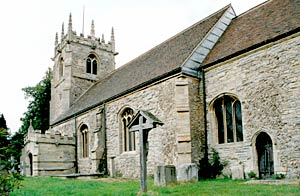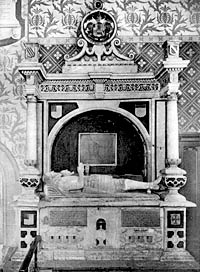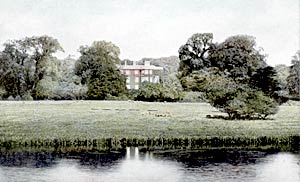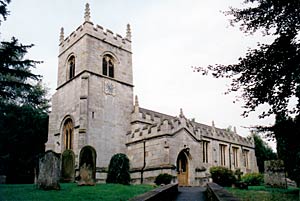< Previous | Contents | Next >
The Proud Suttons

Averham church (2000).
AVERHAM. Its glory is the exquisite setting of its fine little church, which stands high on a bank of the Trent with a wealth of trees in the churchyard, and a magnificent cedar in the lovely garden of the rectory lifting its branches above the tower. With the fine sweep of the river, and the view across the meadows of Newark and its tapering spire, it is one of the fairest scenes in the valley of the Trent. In a wall of the rectory garden is a 15th century window from Southwell Minster.
Herringbone masonry in the walls of the church takes its story back to early Norman or even Saxon days, and the rest of it is mainly 14th and 15th century. The tower comes from both these times, the 15th century storey crowned with rich battlements and pinnacles and adorned with quaint gargoyles. The nave and the porch, with the initials of its builder (Sir Thomas Sutton), are also 15th century.
The 600-year-old chancel, which has no arch, has a splendid east window, a priest's doorway, some fine old glass pieced together from fragrnents found at Kelham Hall, and a plain oak screen mostly 500 years old. There is a Jacobean altar table. Fine oak panelling and seating of this century are in memory of Joseph Walker, who was rector here for 51 years, as Richard Sutton had been before him till 1785.
There are many memorials of the Suttons, and the village is proud of its connection with this old family which has now become Manners-Sutton. They lived here and at Kelham, but only a few mounds are left to mark the site of their Averham house, which Cromwell's soldiers destroyed. Robert de Sutton had the estate in the 13th century after the death of his uncle, Henry de Lexington, the last of three famous brothers of Laxton whose name gave the Suttons the title of their peerage in the 17th century. Charles Manners-Sutton followed Richard as rector in 1785, and became Archbishop of Canterbury; his son became Speaker of the House of Commons, and his brother Lord Chancellor of Ireland.
On the floor of the chancel lies a stone figure with sword and shield, perhaps a warrior of the time of King John, and in a recess lies a bearded civilian of the 14th century.

Monument to Sir William Sutton, who died in 1611, aged 52, and his wife Susanna.
On a great tomb with painted decoration lies Sir William Sutton in armour, a courtier of the time of Elizabeth. He is with his lady, and part of the inscription runs,
Thrice nine years lived he with his lady faire,
A lovely, noble, and like vertuous pair.
On the opposite wall of the chancel is a memorial to their son Robert who was MP for Notts, served Charles Stuart in the garrison at Newark till its surrender, and was created Baron Lexington for his help in raising money. His son Robert, who was born at Averham in 1661 and became 2nd Lord Lexington, was a great diplomatist, and lost his only son at Madrid while he was Ambassador there. The body was sent home in a bale of cloth, and both parents and son sleep at Kelham, where a great tomb keeps their memory green.
A Pilgrim Father

Babworth Hall and lake, c.1905.
BABWORTH. A singularly charming spot it is, among gently swelling hills and lovely trees, quiet and secluded, though the stir of Retford is only a mile away. Swans glide by the wayside on the lovely winding lake, from which fine parkland rolls up to the creepered hall and to the many-gabled and many-chimneyed rectory.
To the little church hiding among its yew hedges, encircled by mighty horse chestnuts, sycamores, yews, cedars, and beeches in the grounds of the hall, William Bradford used to come from his home at Austerfield ten miles away. He became one of the most remarkable of the Pilgrim Fathers who sailed in the Mayflower.

Babworth church (2000).
The old church is adorned with battlements and pinnacles, and has a low 15th century tower. The ancient porch has a stone roof with four ribs ending in tiny corbel heads worth finding, among them being a dainty human face and a grotesque animal. The nave and chancel are all in one, and an old arcade divides the nave from a wide aisle, one of its arches resting on a huge grotesque. The most pleasing glass makes a patch of blue, red, gold, and green in the west window of the tower, showing Noah's Ark and the dove with a spray of olive, John the Baptist, and Moses with the Ten Commandments.
Of the many memorials to the Simpsons who lived at the hall (a small part of which comes from about 1600), two are in great contrast. One is an ornate monument with a painting on glass of the Resurrection, set in a stone wreath of flowers; at each side is an ungainly cherub, who has put down his harp and his scroll of music in order to weep more copiously. The other memorial tells of a little midshipman who died when only 15, from a fever caught at the Cape Verde Islands.
Into Babworth's little gallery of heroes comes Arthur Hardolph Eyre, who was 23 when he was killed in 1874 during the last engagement of the Ashanti War. He fell while leading the advance on Coomassie, and his memorial window shows two small scenes of the war. He was the brave son of a brave father, General Sir William Eyre, who fought in the Crimea.
We read of Harry Doad that he was 24 when he died at Baden-Baden while trying to save the lives of others; and an inscription in a fine alabaster frame tells of 18 men who died for peace.
